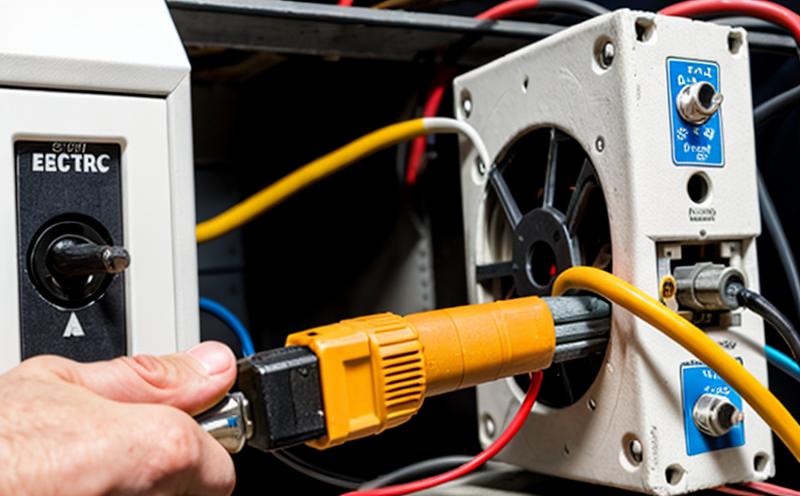EN 61000-6-3 EMC Emission Test for Residential Equipment
The EN 61000-6-3 standard is a crucial part of the broader family of EMC (Electromagnetic Compatibility) standards, specifically focusing on electromagnetic emissions from residential equipment. This test ensures that devices like home appliances and consumer electronics do not emit excessive levels of radio frequency interference (RFI) into their environment, which could potentially cause malfunctions in other nearby electrical devices.
The process involves measuring the emitted RF fields by the device under test within a specific frequency range, typically from 150 kHz to 8 GHz. The testing is conducted using an anechoic chamber designed to absorb electromagnetic radiation and minimize interference with external signals. The specimen preparation involves ensuring that all connections are secure and the equipment is set up in its intended operating environment.
The instrumentation used for this test includes a spectrum analyzer, which captures the emitted signal at different frequencies. The results of these measurements must comply with the limits specified in EN 61000-6-3 to ensure that the device does not interfere with other devices operating within the same frequency range. Compliance is essential for market access and customer satisfaction.
Real-world applications include ensuring safety in crowded environments, such as homes where multiple devices are used simultaneously. By passing this test, manufacturers can guarantee their products meet international standards, thereby enhancing trust among consumers and facilitating global sales.
- The standard is recognized globally by various national standards organizations, including ANSI (American National Standards Institute), BSI (British Standards Institution), DIN (Deutsches Institut für Normung), AFNOR (Association Française de Normalisation), JIS (Japanese Industrial Standards), and others.
- Compliance with EN 61000-6-3 is a requirement for products sold in Europe, the United States, Canada, Australia, New Zealand, Japan, South Korea, and many other countries around the world.
- The acceptance of this standard ensures that manufacturers can market their equipment globally without facing significant compliance issues.
For R&D engineers, passing this test is critical for innovation. By adhering to these standards early in the design phase, they ensure that their products are future-proof and meet the stringent requirements of international markets. Quality managers and procurement officers should prioritize suppliers who comply with such standards to maintain a high standard of product quality.
Why It Matters
The EN 61000-6-3 EMC Emission Test is essential for ensuring the safe and reliable operation of residential equipment. Excessive electromagnetic emissions can lead to interference with other devices, which may result in malfunctions or even damage to sensitive electronics. This test helps prevent such issues by setting strict limits on the amount of RFI that a device can emit.
The test is particularly important for manufacturers as it ensures their products meet international standards, thereby facilitating global sales and market access. Compliance with this standard also enhances customer satisfaction by providing assurance that the product will not cause interference in its intended environment. This is especially crucial in residential settings where multiple devices are often used simultaneously.
In addition to safety considerations, the test also contributes to environmental protection. By minimizing RFI emissions, manufacturers can help reduce electromagnetic pollution and prevent potential harm to wildlife and ecosystems. This aligns with broader sustainability goals and helps build a more environmentally friendly industry.
For quality managers and compliance officers, passing this test is crucial for maintaining product integrity and ensuring adherence to regulatory requirements. It also supports the company's reputation by demonstrating commitment to high-quality standards and safety.
Customer Impact and Satisfaction
The EN 61000-6-3 EMC Emission Test has a direct impact on customer satisfaction. By ensuring that the device does not emit excessive levels of RFI, it prevents interference with other devices in the home environment. This results in a more stable and reliable user experience, which is particularly important for sensitive equipment like medical devices or high-end audio systems.
Customers appreciate products that are proven to be safe and compatible with their existing electronics. Compliance with this standard builds trust between manufacturers and consumers, fostering long-term relationships based on reliability and satisfaction. This trust is further strengthened when the product is recognized as meeting international standards, which can significantly enhance brand reputation.
In addition to customer satisfaction, compliance also reduces the risk of product returns or warranty claims due to compatibility issues. This not only saves time and resources for the manufacturer but also improves overall service quality. By ensuring that their products meet this standard, manufacturers demonstrate a commitment to delivering high-quality products that meet the needs of their customers.





